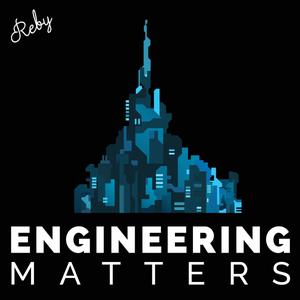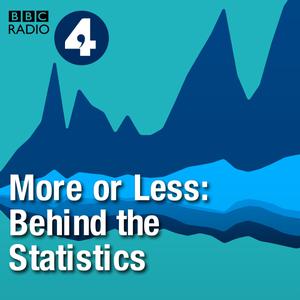
Engineering Matters
Reby Media
Engineering Matters
- 29 minutes 12 seconds#275 Serving Countries to Serving Communities
For any military operation the objectives of the mission are absolutely paramount. Failure is not an option. The team is motivated to achieve a common goal, often working under extreme pressure, pulling together to overcome challenges, paying attention to detail and always prioritising the objectives of the mission. In this way veterans have a lot to offer construction and infrastructure projects.
In this podcast we explore how veterans are using their military skills in new ways from serving their country to serving communities. We find that their experience of working in a dynamic and demanding environment enables a very unique understanding of the objectives of a major project and a skills set that is primed for successful delivery.
Guests
John Buck, program manager, Mott MacDonald
Jan Kozlowski, director operating capital projects and work equipment, Metro North Railroad (MNR)
Heather “M” McCray, structural engineer, Mott MacDonald
Frank Townsend, president, Patriot Shotcrete
Partner
Mott MacDonald is a global engineering, management and development consultancy focussed on improving society by considering social outcomes and relentlessly focussing on excellence and digital innovation.
The post #275 Serving Countries to Serving Communities first appeared on Engineering Matters.
16 May 2024, 10:01 am - 28 minutes#274 Seeing the Future of a City
Dar es Salaam is one of the world’s fastest growing cities. In the 1970s, it was home to less than one million people. Today, it has a population of more than five million people, and by 2035 it is projected to have more than 13 million residents.
The city sits on a natural harbour, the Zanzibar channel, and is crossed by a series of short rivers and tributaries. These supported the population, and helped build its position as one of Africa’s most important ports. But as climate change takes effect they bring risks: of flood, and of disease. And, like other cities, Dar es Salaam also faces intolerable heat, with the urban heat island effect adding to global temperature rises.
As the Tanzanian government starts a second tranche of development in the city, with the support of the World Bank, it wanted to consider the impact of using more nature-based engineering techniques. In this episode, we learn how engineers from Arup made use of flood mapping from Fathom, as they calculated the impact of urban greening on the city.
Guests
Caroline Ray, regional director, East Africa, Arup
Gavin Lewis, head of engineering markets, Fathom
Dr Natalie Lord, principal climate scientist, Fathom
Anthony Cooper, hydraulic modeller, Fathom
Partner
Fathom gives risk management professionals the most scientifically robust intelligence to understand the climate’s effects on water risk. By publishing cutting-edge peer-reviewed academic research and applying it to real-world challenges, Fathom enables stronger decision-making for (re)insurance, civil engineering, corporate risk, financial services, disaster response and government.
The post #274 Seeing the Future of a City first appeared on Engineering Matters.
9 May 2024, 11:53 am - 31 minutes 46 seconds#273 The Core Technologies of a New Power System
In this episode, we delve into the dynamic world of Power Electronics, Machines, and Drives (PEMD), exploring its pivotal role in shaping the future of energy systems and sustainability efforts.
PEMD technology plays a critical role in advancing electrification and decarbonisation efforts worldwide. With PEMD technology enabling the integration of renewable energy sources, improving energy conversion efficiency, and driving advancements in electric mobility, the industry is poised to play a pivotal role in shaping a more sustainable energy future.
But creating an industry from diverse sectors that include academics, government organisations and the commercial side of the industry, requires commitment and vision. Conferences like PEMD 2024 are crucial platforms for fostering collaboration, sharing knowledge, and driving innovation within the PEMD community. The conference, organised by the IET, will shed light on the diverse range of topics, from integrated motor drives to advanced control techniques for high-frequency power electronics, highlighting the interdisciplinary nature of PEMD research.
Guests
Daisy Deng, NUAcT Fellow in Electrical Power Research Group, Newcastle University
Jon King, Midlands regional lead, DER-IC.
Nigel Jakeman, engineering and business development director, Turbo Power Systems
Partner
The Institution of Engineering and Technology inspires, informs and influences the global engineering community to engineer a better world. As a diverse home across engineering and technology, the IET shares knowledge that helps make better sense of the world in order to solve the challenges that matter. PEMD 2024 takes place at the East Midlands Conference Centre in Nottingham, from June 10–13 2024.
The post #273 The Core Technologies of a New Power System first appeared on Engineering Matters.
2 May 2024, 10:47 am - 41 minutes 22 seconds#272 Designing Dinorwig: Inside Electric Mountain
In late 1973 the UK’s Central Electricity Generating Board gained parliamentary approval to build the largest and most difficult pumped storage hydroelectric power station in its history. It was the largest civil engineering contract ever awarded by the government and became the biggest construction project in Europe. Engineering teams had to burrow 750m deep into the Cambrian slate of Elidir Fawr mountain at Dinorwig, North Wales to create the underground power station and a 16km labyrinth of tunnels up to 10.5m in diameter linking upper and lower reservoirs.
It’s scale and complexity pushed the limits of design and construction with engineers developing state of the art practices for rock reinforcement and concrete design and pioneering new construction methods. As the station celebrates 40 years of operation and looks ahead to a bright future as a battery for renewable energy, we speak with the people that planned, designed and constructed electric mountain hearing stories that have never been told before.
Guests
Kin Almond, supervising civil engineer, James Williamson & Partners
John Armstrong, station manager Dinorwig and Ffestiniog, First Hydro
James Arthur – senior engineer, James Williamson & Partners
John Cowie – associate, James Williamson & Partners
Chris Roberts, commissioning engineer, Central Electricity Generating Board (CEGB)
Dyfrig Roberts – assistant engineer, James Williamson & Partners
Robin Thomas – civil engineering technician, James Williamson & Partners
Ian Waite – project surveyor, James Williamson & Partners
Musical recording of “Tydi a Roddaist” used with the permission of the Caernarfon male voice choir who performed in the excavated machine hall in 1979.
Partner
Mott MacDonald is a global engineering, management and development consultancy focussed on improving society by considering social outcomes and relentlessly focussing on excellence and digital innovation. James Williamson & Partners became part of Mott MacDonald in 1990.
The post #272 Designing Dinorwig: Inside Electric Mountain first appeared on Engineering Matters.
25 April 2024, 9:02 am - 20 minutes 44 seconds#271 Pumped Storage: Australia tackles Intermittency
On the receiving end of among of the worst natural disasters in modern history, while being blessed with some of the most abundant natural resource reserves, and a developed economy, Australia sits in a unique position with regards to climate change.
Many eyes are on the country as it looks to maintain the grid resilience of its traditional coal-fuelled economy, while undertaking one of the most dramatic shifts to renewables in the developed world.
The southern continent walks an uncharted path, with enormous challenges, but with every advantage. A realistic route to renewable energy is possible if it embraces established technology.
Guests
Vinod Batta, Global Lead for Hydro and Pumped Hydro, AtkinsRéalis
Tom Hasker, CEO – Australia and New Zealand, AtkinsRéalis
Sebastien Mousseau, Global Lead for Power and Renewables, AtkinsRéalis
Resources
For the WWF Australia report, Restoring habitat for fire-impacted species’ across degraded Australian landscapes, click here
For the International Energy Agency’s review of Australia’s climate policies, click here
Partner
AtkinsRéalis is one of the world’s most respected design, engineering and project management consultancies. Employing over 18,000 people across the UK, North America, Middle East and Africa, Asia Pacific and Europe, AtkinsRéalis uses the latest technology to deliver major capital projects, and provide expert consultancy for clients across the energy, transportation and infrastructure sectors.
The post #271 Pumped Storage: Australia tackles Intermittency first appeared on Engineering Matters.
18 April 2024, 3:15 pm - 29 minutes 37 seconds#270 A Blueprint for Low Carbon Roads
In the UK, over a quarter of a million kilometers of road have been laid. From motorways and A-roads to small country lanes, every kilometer of construction comes with a big carbon cost, emitting up to 2,600 tonnes of CO2 equivalent per kilometer.
Over the last decade investment into new material technology and machinery has produced an array of tools for the road construction industry to use which can reduce carbon emissions. We’ve previously explored some of these individual innovations, such as warm mix asphalt and the UK’s first ever eMixer.
However, decarbonising road construction can’t be achieved with one or two innovations, it requires careful planning and commitment to decarbonisation, every step of the way. Carbon emissions are found at every stage of the process, from quarries to asphalt plants, to the road construction site, and the transport in between.
In 2023 Stockton-on-Tees council and Hartlepool council, together with Tarmac completed three ambitious road projects. With help from across the supply chain, they aimed to reduce the carbon emissions at every stage as much as possible. By electrifying quarry equipment, using Hydrotreated vegetable oil (HVO) as a fuel source and using groundbreaking material technology, together these efforts reduced their carbon emissions by 84%. Now, Tarmac is joining forces with National Highways to take that blueprint for low carbon roads across the strategic road network.
Guests
Chris Wright, general manager of paving in the Northeast of England and Scotland, Tarmac
Stephen Elderkin, director of environmental sustainability, National Highways.
Partner
Tarmac is the UK’s leading sustainable construction materials, road contracting and building products business. It leads in the supply of construction material comprising aggregates, asphalt, cement, lime, concrete, road contracting, building products and recycling services.
The post #270 A Blueprint for Low Carbon Roads first appeared on Engineering Matters.
11 April 2024, 10:59 am - 41 minutes 10 seconds#269 The Pipeline to Net Zero
It will be just as important to upgrade pipeline networks for the energy transition, as it is the electric grid. These will carry carbon dioxide and hydrogen, along with ammonia and biogas. They will enable carbon capture, local hydrogen for fuel intensive industry and transport, and for export.
Governments around the world have struggled to develop these networks. The UK’s strategy is to create clusters of carbon emitters to make use of offshore carbon storage. These can take advantage of legacy pipeline infrastructure in historic industrial regions, and bring new opportunities to struggling economies.
In this episode, we speak to pipeline and energy experts about the technical and project management challenges of building these new networks.
Guests
Laura Hughes, energy sector director, Costain
Sean Gleeson, project manager, PX
Niku Nobakhti, project manager, Costain
Ewan Brodie, consultancy and advisory manager, Costain
The post #269 The Pipeline to Net Zero first appeared on Engineering Matters.
4 April 2024, 10:44 am - 28 minutes 41 secondsLearning Legacy Podcast – Episode 5: How to Swim in a Sea of Data
HS2 is one of the most complex and challenging railway scheme the UK has ever undertaken. As such, it has been generating vast amounts of data across the board. Every geological survey, every design, every site, every environmental survey, all generating more and more data.
So with all this data, what do you do with it?
The final episode of the Learning Legacy Podcast looks at how HS2 has been using their data to build more detailed models, advance approaches to work and better equipment that can provide greater insights into the world of construction engineering.
Featuring:
- Roberto Alberola – TYPSA, Head of BIM and Digital
- Peter Ruff – SCS, Head of BIM
- Jonny Neville – Mott Macdonald, Engineering Geologist and Information Manager
- Idarousse Mouhtar – BBV, Senior Materials Engineer
- Dr Anne-Marie Imafidon MBE – Social Entrepreneur and Computer Scientist
Roberto and Peter dive into the creation of a digital version of the project using Building Information Modelling (BIM) and ensuring there is a single point of truth so all designers and contractors along the length of the project are on the same page.
Jonny and Idarousse talk through the process of earthworks excavation by using a new 3D GeoBIM model which allows for more advanced ground investigation surveys. Further pushing the importance of the planning process before putting a spade in the ground.
Dr Anne-Marie closes out the series with an extract from her speech given at HS2’s Learning Legacy Live event. Highlighting having a growing mindset, experimenting along with learning from our actions and asking “how” we do things.
“Recognise and use that influence you are owning, up to something you are able to share, you are re-sharing and building based on the lesson that’s come from someone else. There’s something magical actually in being able to do that.” – Dr Anne-Marie Imafidon
To find out more about HS2’s Learning Legacy Programme, click the link below
Homepage – HS2 Learning Legacy
Papers Featured in this episode
Driving efficiency and sustainability in material reuse through GeoBIM – HS2 Learning Legacy
The post Learning Legacy Podcast – Episode 5: How to Swim in a Sea of Data first appeared on Engineering Matters.
28 March 2024, 10:35 am - 28 minutes 25 secondsLearning Legacy Podcast – Episode 4: Being Safe and Inclusive Every Step of the Way
HS2 is focused not only on safety, but on overall health and wellbeing on all employees and contractors. Identifying long term risks to wellbeing is a challenge within any industry. It’s a particular problem on construction sites, where people often move between projects and sites.
Episode 4 dives into some of the innovations and technology being implemented across the project. From monitoring site workers exposure to Hand Arm Vibration Syndrome, to understanding the approach in place at BBV to ensure teams are establishing an inclusive and safe culture for all employees.
Featuring:
- Fiona King – HS2, Head of Occupational Health and Wellbeing
- Timothy Callow – EKFB, SHW Advisor
- Alison Crawley – EKFB, Head of Occupational Health
- Bill Strachan – EKFB, Health Safety and Wellbeing Manager
- Chloe Chand – Diversifying Group, Lead Diversity and Inclusion Trainer (Former BBV, EDI Partner)
- Ben Hickman – BBV, EDI Partner
Fiona outlines the importance of occupational health. Monitoring a workers’ health from the design stages onwards allows teams to take action against signs of long-term health issues at the earliest moment.
Tim, Alison and Bill explain the journey of improving the problem of Hand Arm Vibration Syndrome of workers putting together a concrete batching plant, and the use of a React Tech vibration monitor device allowing managers to rethink their approach on the job.
Chloe and Ben walk us through BBV’s approach to ensure an equal and inclusive environment is achieved. From the 4 Golden Rules to ensuring any lack of understanding or awareness is addressed in a civil and respectful way. Inclusion of all when monitoring health and safety is critical to help continue to push the industry.
“The concept of Learning Legacy is understanding what legacy you want to have or be known as, but also the whole point about learning is it’s continuous. We’re always learning.”
– Ben Hickman
To find out more about HS2’s Learning Legacy Programme, click the link below
Homepage – HS2 Learning Legacy
Papers Featured in this episode
Control of hand and arm vibrations on HS2 and beyond – HS2 Learning Legacy
Safe at Heart: establishing an inclusive and safe culture for our employees – HS2 Learning Legacy
The post Learning Legacy Podcast – Episode 4: Being Safe and Inclusive Every Step of the Way first appeared on Engineering Matters.
28 March 2024, 10:32 am - 30 minutes 33 secondsLearning Legacy Podcast – Episode 3: Reducing and Reusing
HS2’s place within the current climate and environment has always been its top priority. Once operational, the British-built bullet trains will provide zero-carbon journeys between the UK’s two largest cities, Birmingham and London.
Episode 3 explores how HS2’s railway assets have been designed from the start with climate change resilience in mind, as well as utilising waste clay from tunnelling, and how it can be transformed into low carbon concrete.
Featuring:
- Kay Hughes – HS2 Design Director
- Alison Walker – HS2 Climate Change Manager
- Dr Rachel Allison – HS2 Climate Change Specialist
- Nick Podevyn – Align Innovation Manager
- Athina Papakosta – SCS Sustainability and Carbon Lead
- Dr Fragkoulis Kanavaris – ARUP Concrete Materials Lead
- Apostolos Tsoumelekas – SCS Materials Engineer
- Tom Burr-Hersey – HS2 Senior Environmental Manager
Kay sets the scene with how the project is being delivered with the future in mind, achieving sustainability from as early as the design stage and maintaining it through strong communication.
Alison and Rachel take us through all things climate when it comes to construction of the project. ‘The 4R’s of resilience’, the planning towards weather conditions by using multiple climate models, and how much climate adaption is front and centre from design all the way through to operation.
Nick focuses on the construction of the Colne Valley Viaduct with Align’s giant launch girder. Combating issues with wind, rain and heat to ensure the construction schedule isn’t affected and the use of MetSwift weather models.
Athina, Fragkoulis, Apostolos and Tom dive into the reuse of London Clay to reducing climate impact by cutting transport emissions related to removing the material. The possibility of excavated London Clay being turned into local concrete, it could also reduce the embodied carbon emissions.
‘l think a project of this scale has so many different aspects and things that need to be thought about. And I think as Allison said, it was no one person can do all of this. So having it all set out, make sure that it is considered and it doesn’t get lost in the scale of the project.’
– Dr Rachel Allison
To find out more about HS2’s Learning Legacy Programme, click the link below
Homepage – HS2 Learning Legacy
Papers featured in this epsiode
Delivering a climate change resilient railway – HS2 Learning Legacy
The post Learning Legacy Podcast – Episode 3: Reducing and Reusing first appeared on Engineering Matters.
28 March 2024, 10:29 am - 28 minutes 29 secondsLearning Legacy Podcast – Episode 2: The Blueprint and the Real Thing
Design not only encapsulates the creativity and innovation of new products, but is the main source of information for construction to take place. Episode 2 of the Learning Legacy Podcast takes a look at the design stages of stations and tunnel portals and encapsulating the importance of finding new methods of work and finding the...
The post Learning Legacy Podcast – Episode 2: The Blueprint and the Real Thing first appeared on Engineering Matters.
28 March 2024, 10:25 am - More Episodes? Get the App
Your feedback is valuable to us. Should you encounter any bugs, glitches, lack of functionality or other problems, please email us on [email protected] or join Moon.FM Telegram Group where you can talk directly to the dev team who are happy to answer any queries.
 Cautionary Tales with Tim Harford
Cautionary Tales with Tim Harford
 The Rest Is History
The Rest Is History
 Science In Action
Science In Action
 More or Less: Behind the Stats
More or Less: Behind the Stats
 The Infinite Monkey Cage
The Infinite Monkey Cage